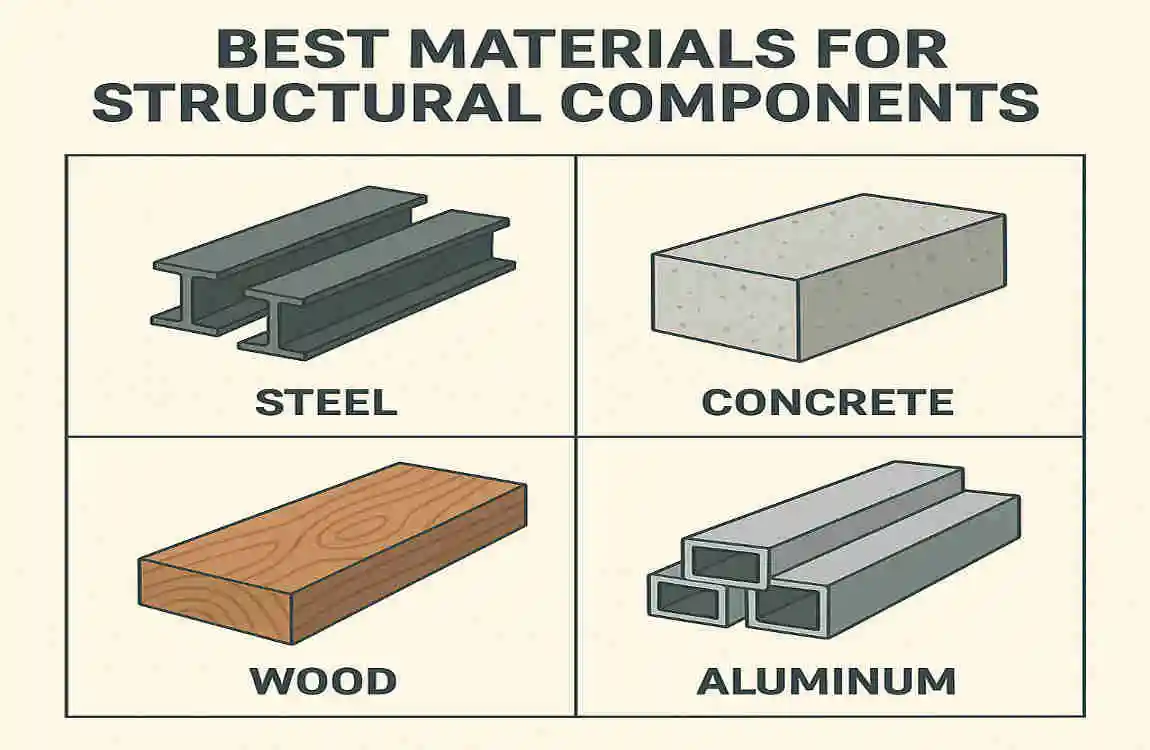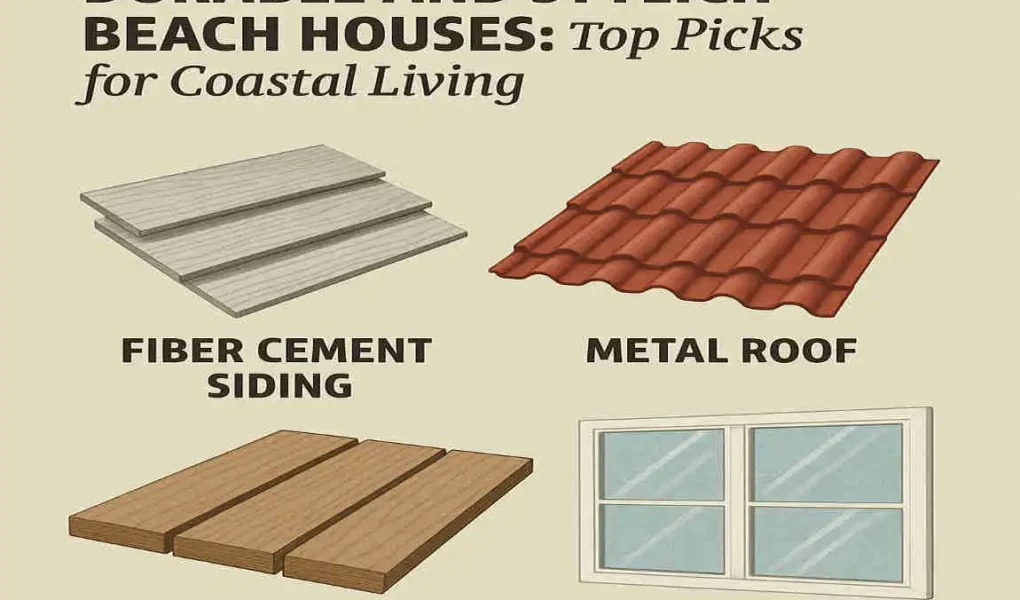The best building materials for durable and stylish beach houses are those that can withstand harsh coastal conditions such as moisture, salt air, high winds, and storms while also offering aesthetic appeal. Top choices include concrete, renowned for its strength, low maintenance, and excellent resistance to wind, water, and salt corrosion, making it ideal for foundations and structural elements. Pressure-treated lumber, specially treated to resist moisture, rot, and insects, brings classic wood charm while maintaining durability. Fiber cement siding is another excellent option, combining weather resistance with the ability to mimic wood or stone textures, providing a stylish yet tough exterior. Corrosion-resistant stainless steel hardware ensures long-lasting structural integrity against salty air corrosion. Impact-resistant windows and doors protect against storms while enhancing energy efficiency. For roofing, durable metal materials are preferred due to their rust resistance and strength against high winds. Incorporating these materials in a design with open floor plans, large windows, elevated foundations, and natural elements completes a beach house that is both beautiful and built to last in coastal environments.
Understanding Coastal Environmental Challenges

Living by the ocean is spectacular, but Mother Nature doesn’t pull any punches when it comes to testing your modren home’s resilience. Understanding these challenges is your first step toward making smart material choices.
Wind and Storm Considerations
Coastal homes face wind speeds that inland properties rarely experience. During storm season, hurricane-force winds can exceed 150 mph, turning everyday objects into projectiles and putting enormous stress on your home’s structure.
Your beach house needs to withstand not just the average daily breeze but also those extreme weather events that occur every few years. This means thinking beyond aesthetics and prioritizing materials that can flex without breaking and resist impact damage.
UV Exposure and Fading
The same sunshine that makes beach living so appealing can be brutal on building materials. UV rays are significantly stronger near reflective surfaces, such as water and sand, accelerating the fading and degradation of many materials.
Traditional wood siding might look gorgeous initially, but without proper treatment, it can turn gray and weathered within just a few years. Plastics can become brittle, and certain paints can chalk and fade, leaving your dream home looking tired and worn.
Low Maintenance Requirements
Let’s be honest—you want to spend your beach house time relaxing, not constantly maintaining your property. Select materials that require minimal maintenance to maintain their appearance.
Materials like fiber cement siding or composite decking may cost more initially, but they can free you from the annual painting, staining, or sealing routines. Think about the long-term time and money you’ll save when making your selections.
Storm-Proofing Capabilities
Your modren beach house materials must work together as a cohesive system to resist storm damage. This means choosing materials that can handle high wind loads, flying debris, and potential flooding.
Impact-resistant windows, reinforced roofing systems, and sturdy structural materials form your first line of defense. Look for materials that meet or exceed local building codes for coastal construction.
Aesthetic Appeal
While durability is crucial, you also want a beautiful beach house that captures that relaxed, coastal vibe. The good news? Many modern materials combine exceptional durability with beautiful aesthetics.
Today’s fiber cement can mimic wood grain perfectly. Metal roofing comes in styles that resemble traditional shingles or tiles. You no longer have to sacrifice style for substance.
Best Materials for Structural Components

The bones of your Smart beach house need to be incredibly strong and resistant to all the challenges we’ve discussed. Let’s examine the top choices for structural elements.
Concrete and Cement
Concrete may not be the first material that comes to mind for a modern beach house, but it’s one of the best choices for coastal construction. Modern concrete homes can be surprisingly stylish while offering unmatched durability.
Poured concrete walls resist everything the coast can throw at them—salt, wind, water, and pests have virtually no effect on properly mixed and cured concrete. Insulated concrete forms provide excellent energy efficiency along with storm resistance that can withstand Category 5 hurricanes.
For foundations and ground-level structures, concrete is simply unbeatable. It won’t rot, corrode, or provide food for termites. Concrete piers elevate your home above potential flood waters while creating usable space underneath for parking or storage.
The aesthetic options have expanded dramatically, too. Decorative concrete can be stamped, stained, or textured to resemble stone, tile, or other materials. You can achieve that coastal cottage look while enjoying concrete’s incredible durability.
Steel and Metal Frames
Steel framing has become increasingly popular in coastal house construction, and for good reason. Steel studs don’t warp, rot, or attract termites, making them ideal for beach house construction.
When properly coated or galvanized, steel framing resists corrosion exceptionally well. The strength-to-weight ratio of steel enables larger open spaces and creative architectural designs that capture stunning ocean views. Steel frames can also withstand extreme wind loads better than traditional wood framing.
Consider using stainless steel or aluminum for exposed structural elements. While more expensive, these materials offer superior corrosion resistance, eliminating the need for regular maintenance or recoating.
Treated and Engineered Wood
Many people can’t imagine a beach house without wood, and fortunately, modern wood treatments make this traditional material viable for coastal construction. Pressure-treated lumber , designed for marine environments, can last for decades when properly maintained.
Cedar and redwood contain natural oils that resist moisture and insects, making them excellent choices for homes located on the coast. Teak, though expensive, offers unparalleled durability and beauty for exposed applications.
Engineered wood products, such as laminated veneer lumber and glued laminated timber offer superior strength and stability compared to traditional lumber. These materials resist warping and splitting while preserving the natural beauty house of wood.
Best Exterior Finishes and Cladding Materials

Your home’s exterior faces the harshest conditions, so selecting the right cladding is crucial for both protection and maintaining a good curb appeal.
Natural Stone and Stucco
For ultimate durability and a high-end appearance, natural stone cladding is hard to beat. Stone is completely impervious to salt, moisture, wind, and UV damage. While installation costs are high, stone cladding can last centuries with virtually no maintenance.
Stucco offers similar benefits at a lower cost. Traditional cement stucco, when properly applied over suitable backing materials, creates a seamless, durable exterior that resists coastal conditions exceptionally well.
Modern synthetic stucco systems offer additional insulation but require meticulous installation to prevent moisture-related issues. In coastal areas, traditional cement stucco often performs better due to its breathability.
Roofing Materials Ideal for Beach Houses

Your house roof bears the brunt of sun, wind, and rain, making material selection critical for long-term performance.
Metal Roofing
Metal roofing stands out as perhaps the best overall choice for coastal homes. Aluminum and steel roofing systems offer exceptional durability, energy efficiency, and resistance to storms.
Metal roofs can withstand winds exceeding 140 mph when properly installed and maintained. They reflect solar heat, keeping your home cooler and reducing energy costs. The smooth surface sheds water quickly and resists the growth of mold and mildew.
Modern metal roofing comes in styles that mimic traditional shingles, tiles, or shakes. Standing seam metal roofs offer a contemporary look that complements modern beach house architecture perfectly.
Choose aluminum for ultimate corrosion resistance or galvanized steel for a balance of cost and performance. Both options can last 50+ years with minimal maintenance.
Clay and Concrete Tiles
Tile roofing offers a classic coastal Mediterranean look while providing excellent durability. Clay and concrete tiles resist salt air, UV damage, and moisture, remaining durable over time.
The weight of tile roofing requires a strong structural system, but this mass helps resist wind uplift. Modern installation methods, which utilize foam adhesives and mechanical fasteners, ensure that tiles remain in place during storms.
Concrete tiles can be manufactured to resemble wood shakes, slate, or traditional barrel tiles. They offer similar performance to clay at a lower cost, though they may fade slightly over time.
Interior Materials for Durability and Style

The interior of your beach house requires materials that can withstand humidity while creating the relaxed coastal atmosphere you’re after.
Flooring Options
Tile flooring excels in beach houses due to its moisture resistance and easy cleaning. Porcelain tiles can mimic the appearance of wood, stone, or other materials while offering superior durability.
If you prefer wood floors, select a species known for its stability in humid conditions. Teak, mahogany, and properly sealed oak can work well. Engineered hardwood offers superior dimensional stability compared to solid wood.
Luxury vinyl plank house flooring has become incredibly popular in coastal homes. It’s completely waterproof, comfortable underfoot, and available in convincing wood and stone patterns.
Cabinets and Furniture Materials
Kitchen and bathroom cabinets are exposed to constant humidity. Marine-grade plywood or solid wood cabinets with proper sealing outperform particleboard options.
Stainless steel hardware resists corrosion better than standard metals. For a more traditional look, choose brass or bronze hardware with protective coatings.
Consider furniture made from naturally moisture-resistant materials, such as teak, cedar, or synthetic wicker. These materials maintain their appearance without constant maintenance.
FAQ: What is the Best Building Material for a Beach House?
Q: What are the key considerations for beach house building materials?
When selecting materials, prioritize:
- Durability: Resistance to salt, humidity, and weathering.
- Low maintenance: Materials that don’t require frequent upkeep.
- Weather resistance: Ability to withstand strong winds, storms, and corrosion.
- Sustainability: Eco-friendly options that are long-lasting and efficient.
Q: What are the best materials for beach house exteriors?
- Concrete:
- Highly durable and resistant to salt, moisture, and strong winds.
- Can be reinforced for added strength.
- Fiber Cement Siding:
- Resists rot, warping, and pests.
- Low-maintenance and available in various styles.
- Pressure-Treated Wood:
- Treated to resist rot, mold, and termite damage.
- Works well for decks and exterior accents but requires sealing or staining.
- Aluminum or Galvanized Steel:
- Ideal for roofing and window frames due to corrosion resistance.
- Lightweight and strong against high winds.
- Stucco:
- A traditional and durable option for coastal areas.
- Provides insulation and weather resistance.
Q: What are the best materials for roofing a beach house?
- Metal Roofing:
- The most popular choice for beach houses due to its resistance to corrosion, wind, and fire.
- Reflects sunlight, helping to keep the house cool.
- Clay or Concrete Tiles:
- Extremely durable and resistant to salt and moisture.
- Ideal for coastal aesthetics but heavier than metal.
- Asphalt Shingles (Coastal Grades):
- Affordable and wind-resistant varieties are available.
- Not as durable as metal or tile but a budget-friendly option.
Q: What materials are best for beach house flooring?
- Porcelain or Ceramic Tile:
- Highly durable, moisture-resistant, and easy to clean.
- Available in slip-resistant finishes for wet areas.
- Luxury Vinyl Plank (LVP):
- Mimics the look of wood but resists moisture, warping, and salt damage.
- Engineered Hardwood:
- More resistant to humidity than solid wood.
- Prefinished options with marine-grade coatings can last longer.
- Concrete Floors:
- Durable and low-maintenance, offering a modern look.
- Can be polished or stained for aesthetic appeal.
Q: What materials are best for beach house windows and doors?
- Impact-Resistant Glass:
- Essential for hurricane-prone areas. Provides protection against storms and debris.
- Vinyl Frames:
- Resistant to salt, corrosion, and humidity. Low-maintenance and energy-efficient.
- Aluminum Frames:
- Lightweight and corrosion-resistant, ideal for sliding doors and large windows.
- Fiberglass Doors:
- Strong, durable, and less prone to warping in humid conditions.
Q: Are there eco-friendly materials for a beach house?
Yes, there are sustainable options for coastal homes, such as:
- Recycled materials (e.g., reclaimed wood, recycled glass).
- Bamboo for flooring or accents, as it’s renewable and durable.
- Solar panels for energy efficiency.
- Green roofs with vegetation to improve insulation and reduce heat absorption.
Q: What materials should I avoid for a beach house?
Avoid materials that are prone to corrosion, rotting, or damage from salt and humidity, such as:
- Untreated wood: Vulnerable to moisture and pests.
- Iron or untreated steel: Susceptible to rust in coastal environments.
- Cheap vinyl siding: May warp or crack under extreme heat and humidity.
- Low-quality asphalt shingles: Not durable enough for strong coastal winds.
Q: How can I protect my beach house materials from coastal conditions?
- Sealants and Coatings: Use marine-grade coatings or sealants to protect wood, metal, and concrete.
- Regular Maintenance: Inspect and maintain materials periodically to prevent damage.
- Proper Drainage: Ensure proper drainage systems to reduce water and humidity buildup.
- Elevated Construction: Build on stilts or raised foundations to protect against flooding and storm surges.
Q: Can I build a beach house on a budget with durable materials?
Yes, you can. Some cost-effective yet durable materials include:
- Fiber cement siding for exteriors.
- Luxury vinyl plank flooring for interiors.
- Metal roofing for long-term savings.
- Concrete foundations for durability and flood resistance.




